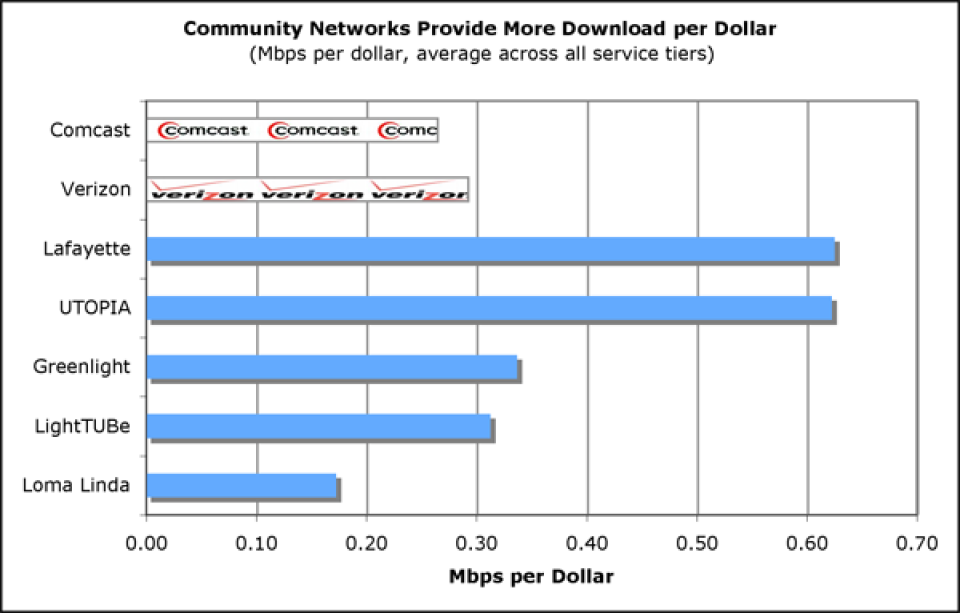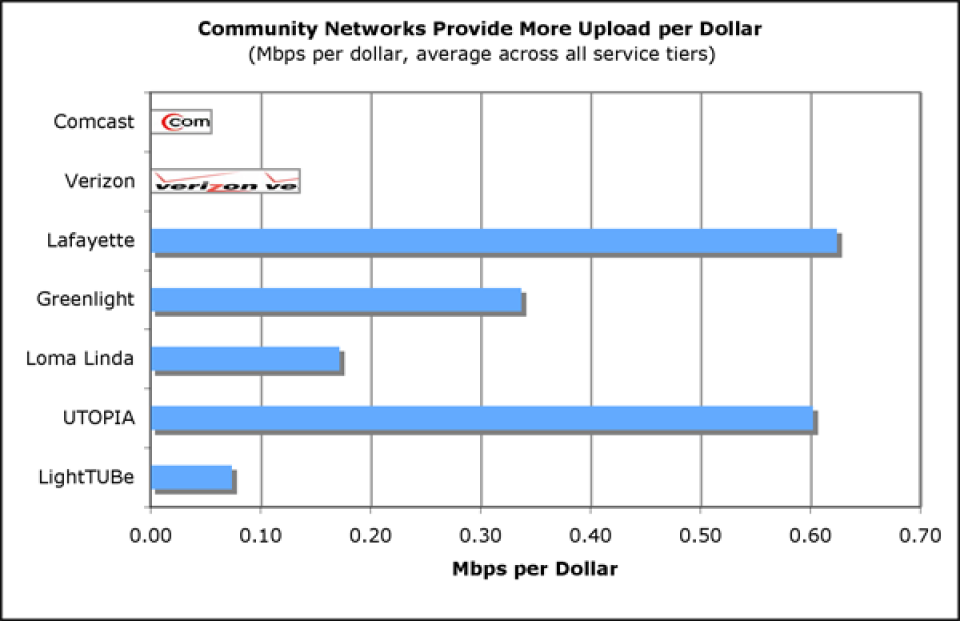Fast, affordable Internet access for all.
lafayette
Content tagged with "lafayette"
Lafayette and Incumbent Responses to New Networks
“Cox froze the cable rates in Lafayette, and they didn’t freeze the rates in other areas,” said Terry Huval, director of LUS, a municipally owned utility company which fought major incumbent opposition before building an FTTH network in Lafayette and starting to offer service earlier this year. “We figured our citizens saved over $3 million in cable rates even before we could offer them service.”I have yet to see a cable company leave a market or reduce investment following the introduction of a public competitor. The opposite tends to happen - they increase investment and often drop prices or leave them lower than in surrounding, non-competitive areas. Often, the rates are not really advertised but if you call from the competitive area, they will offer a better deal:
Trae Russell, communications manager for EATEL, the local telephone franchise in Ascension, La., and some surrounding communities, had seen the same thing happen in his area, when EATEL started offering FTTH-based services in 2006. In fact, EATEL went so far as to take out an ad in the Lafayette newspaper, alerting cable customers there to the discounts that Ascension customers were getting and forecasting similar lower rates in Lafayette once the LUS network was in the works. “It was an incredibly bold move on our part,” Russell said. “Cox came in with an incredibly aggressive promotion for TV service with every bell and whistle you could imagine. We couldn’t figure out how they could even make money on it. So we took out an ad in the Lafayette newspaper that basically said, ‘Hey Lafayette, look at the great prices you are going to get from Cox.’ Cox was not amused.”This is also a lesson for those who want to build a public network. Don't expect to win just because you have a better service and you offer lower prices from what was available before a competing network is built. The incumbent has often already paid off its network. Additionally, incumbents are often larger companies that pay less for their television contracts, so they can lower prices farther than one might expect initially.
Seattle Mayoral Candidate Sees Public Fiber as Essential
But is the fact that people can “only” get slow Internet connections enough to float $450 million in bonds, however financed? McGinn says that there are two separate reasons to push for universal availability. “Access to the Internet is access to the economy, access to the community, in some cases access to democracy, access to issues,” he says. But it’s also about the bottom line: “It’s an essential [piece of] infrastructure to compete in a world economy.”Fleishman also notes a concern frequently cited by incumbent carriers who don't want a public network to compete against:
There have been many concerns raised about public entities, especially those with regulatory power over competitors–such as Seattle’s cable franchise board that controls access to public rights of way and facilities–entering the broadband market. But most of those concerns imply that the market will solve the problem. However, with no requirement for building out service to all customers, or having the same level of service available, an efficient market won’t provide universal coverage.In my experience, this is a theoretical fear. Typically, when a community decides to build its own network, the incumbents rush to upgrade their infrastructure (often after denying that they thought there was a need for faster services in the area). If local governments were abusing their authority over the right of way, you can bet there would have been lawsuits filed - these incumbents have sued over everything else. I do not know of a single successful lawsuit against a local government for what would be a violation of law. Getting back to the interview, they discuss both Lafayette, Louisiana:
The reason for the fight wasn’t about the right to 500 channels, about low prices, or about the city wanting a piece of the action.
Lafayette Plans Faster Growth; US BB Embarrasses; Seattle Needs Volunteers
An article from the Lafayette Advertiser notes: LUS Fiber plans faster rollout. Community networks are frequently attacked by incumbent groups and private providers for failing to immediately turn a profit after launching a network (something we have addressed here). LUS Fiber wisely started slow and will now start to ramp up the number of customers as they progress further along the learning curve of running the fiber-optic network.

As LUS Fiber passes the six-month mark, officials are planning to significantly increase the number of customers and areas that receive television, telephone and Internet service.
The system launched in some areas of the city in February, and thus far, the rollout has been somewhat slower than many anticipated. Lafayette Utilities System Director Terry Huval said the process hasn't gone faster because of a desire to focus on providing high-quality customer service.
"This is a new business," Huval said. "I intentionally held back because I wanted to make sure that every attempt we made to serve a customer was the best we could deliver. Now, we can start really accelerating."
A commentary worth reading: American broadband infrastructure: A national embarrassment
Several months ago, I visited the Netherlands and had the rare opportunity to be personally embarrassed by our terrible broadband infrastructure. The Dutch were literally making fun of me. The fact that our country, with its vast resources and its illustrious history -- Benjamin Franklin, Alexander Graham Bell, Thomas Edison, Steve Jobs -- has such terrible internet service should be an outright national scandal.
Slick Sam and Bandwidth on the Bayou
As promised a few weeks ago, Ellen Perlman has written a piece on the story behind the Lafayette, Louisiana publicly owned FTTH network. This might just be the best network available in the U.S. in terms of offering the fastest speeds at the more affordable prices and offering the most benefit to the community. The path was certainly not easy nor quick but they are now offering services. The video below is a good example of how communities can respond to incumbents that prefer to advertise and lie rather than invest in networks. Fortunately the folks down in Louisiana didn't take Slick Sam lying down - they confronted him and are building a modern network to ensure Lafayette can flourish in the future. They no longer have to beg absentee-run networks for upgrades.
Roundup: Lafayette, Syracuse, Incumbent Bailout, and MAIN
- Lafayette's groundbreaking network is exciting the folks at Governing.com - they say, "The Future of the Internet is in Lafayette, Louisiana."
Ellen Perlman hints are future coverage of the network as well:
To put it in perspective, that's 10 times faster than already very fast Internet. And more than 100 times faster than the Internet "starter" plan that, for example, Verizon is offering. Basically, Lafayette will have a city Intranet, the way universities and technology companies do. So residents will have a very fast connection within the city-parish "campus." Critics wonder why residents need such speeds and why the city had to build its own network. An August story in Governing will get into detail about that.
- Green Party Candidate for the Syracuse City Council speaks out on the need for a publicly owned fiber network in the city:
Hundreds of US cities have municipal ownership of their broadband utilities and their customers pay 30% less on average for cable TV, internet, and phone. Time Warner’s cable franchise is up for renewal. Now is the time to municipalize our broadband utility for (1) lower fees, (2) community control of available channels (from Democracy Now to the NFL Network), (3) quality Public Access, Education, and Government (PEG) programming, (4) universal access to high-speed internet, and (5) up-to-date public access video and web-based media creation centers. Every Syracuse should have first-class, affordable access to internet, cable, and phone communications. The Syracuse economy needs first-rate affordable broadband to progress. The profits now exported to Time-Warner can stay in the community for our own benefit through municipal cable.
Advocates for such a fiber network in Syracuse have a website loaded with resources.
Community Broadband - High Capacity, Low Cost

 Perhaps the most interesting aspect of the data are the baseline speeds available in Wilson North Carolina and Lafayette Louisiana. Lafayette offers a symmetrical 10Mbps connection for $28.95/month whereas Wilson charges $34.95.
I can only imagine how these networks have made their businesses more competitive while cutting telecom budgets for the schools and cities. Imagine being a business in Lafayette with a 50Mbps symmetrical connection when your competition is renting a T-1 at 1.5Mbps for $500/month. 30x the speed at 1/10th the cost. That is a competitive advantage.
In Utah, if Comcast has upgraded to DOCSIS 3 in that area, they'll be charging $140/month for a 50/10 connection when those in the UTOPIA footprint have access to a 100/100 connection for $147.
At least some communities across the U.S. are still competitive with the rest of the world when it comes to Mbps at affordable prices. There is still hope.
Perhaps the most interesting aspect of the data are the baseline speeds available in Wilson North Carolina and Lafayette Louisiana. Lafayette offers a symmetrical 10Mbps connection for $28.95/month whereas Wilson charges $34.95.
I can only imagine how these networks have made their businesses more competitive while cutting telecom budgets for the schools and cities. Imagine being a business in Lafayette with a 50Mbps symmetrical connection when your competition is renting a T-1 at 1.5Mbps for $500/month. 30x the speed at 1/10th the cost. That is a competitive advantage.
In Utah, if Comcast has upgraded to DOCSIS 3 in that area, they'll be charging $140/month for a 50/10 connection when those in the UTOPIA footprint have access to a 100/100 connection for $147.
At least some communities across the U.S. are still competitive with the rest of the world when it comes to Mbps at affordable prices. There is still hope.Services Comparison
Community broadband networks offer some the highest capacity connections at the lowest costs. Many of these communities, before building their networks, were dependent on 1.5 Mbps connections that cost hundreds of dollars, or less reliable DSL and cable networks. The community broadband networks below are full FTTH networks, so the advertised speeds are the experienced speeds -- unlike typical cable advertised speeds, which users pay for but rarely experience due to congestion on the shared connection. In comparing some of the fastest publicly owned broadband networks to some of the fastest national private sector networks, we found that the publicly owned networks offer more value per dollar. Update: A few weeks after this was published, Verizon upped its speeds and prices for several of the tiers.


The data we used is below. We thought about comparing also Qwest's "Fiber-Optic Fast" speeds, but their fastest upload speeds are below 1 Mbps, which makes them too pokey for the above networks.
Community Broadband Networks: The Best of the Best
Note: Speeds are expressed as Mbps Down/Up. Each network has distinct offering for each tier.
| Tier 1 | Tier 2 | Tier 3 | Tier 4 | |||||||
|---|---|---|---|---|---|---|---|---|---|---|
| City | State | Speed | Price | Speed | Price | Speed | Price | Speed | Price | Notes |
| Lafayette | Louisiana | 10/10 | $28.95 | 30/30 | $44.95 | 50/50 | $57.95 | - | - | All connections come with 100Mbps connections to others on the local network. |
| Wilson | North Carolina | 10/10 | $34.95 | 20/20 | $54.95 | 40/40 | $99.95 | 60/60 | $199.95 | There is also a 100/100 tier for $299.95. These prices come from the bundled options. There is one unbundled option - 20/20 for $59.95 |
| UTOPIA | Utah | 15/15 | $39.95 | 30/30 | $49.95 | 50/50 | $59.95 | 100/100 | $147 | This is an open access network, 100/100 is not offered by all service providers |
| Tullahoma | Tennessee | 10/1 | $37.95 | 5/3 | $49.95 | 20/5 | $59.95 | 50/15 | $149.95 | There is also a 100/30 tier for $299.95 |
| Loma Linda | California | 5/5 | $29.95 | 10/10 | $49.95 | 15/15 | $99.95 | - | - | |
| Compare to the best from the private sector: | ||||||||||
| Comcast | DOCSIS 3 in MN | 1/.384 | $39.95 | 12/2 | $59.95 | 16/2 | $69.95 | 22/5 | 79.95 | A higher tier of 50/10 is available for $139.95/month. These are unbundled prices, bundling generally saves $15/month. Speeds are "up to" depending on neighborhood congestion. Comcast marketing makes it difficult to understand what speeds you are paying for. |
| Verizon | FiOS | 10/2 | $49.99 | 20/5 | $59.95 | 20/20 | $69.95 | 50/20 | $144.95 | These are unbundled prices - bundling with phone reduces monthly price by $5. FiOS is not available throughout Verizon footprint. |
The table reflects real rates, not short-term introductory rates. Do not be fooled into thinking that community broadband networks are able to offer the best deal because they are use taxpayer dollars. Very few community networks have ever used taxpayer money. Most networks are built using revenue bonds - which means that private investors fund the network, and are typically repaid over a period of twenty years using revenues generated by the services. Some cities choose to "back" the bonds with taxes -- which means that if the network does not generate sufficient revenue, the city will make up the difference with public money. Other cities choose not to back the bonds; this is a choice made by each community and impacts the interest rate on the bonds. In most cases, community networks have been safe investments that have not missed debt payments because the communities had an urgent need for broadband. In many cases, they have so many people wanting to take service, they have long lists for the installers. The idea that these networks frequently fail is an utter myth. However, not all community broadband networks offer the blazing speeds at great prices displayed above -- some were built five years ago, when those speeds were sufficient. Others do not feel the need to push the envelope, the community is content with what they have. However, they are able to meet higher demands if a citizen requires it. So even if a community network advertises its highest tier as being an 8/1, it is likely able to offer an even faster connection to those who need it. This is one of the many benefits of community broadband - the network is accountable to the community. The community broadband networks being built today almost always offer the fastest speeds currently available - as seen above with two ongoing builds, Lafayette and Wilson.





